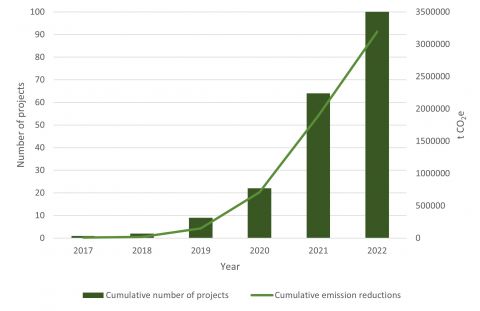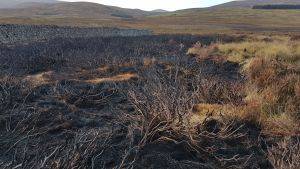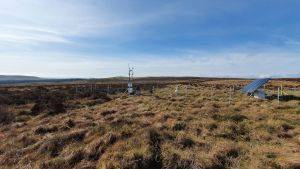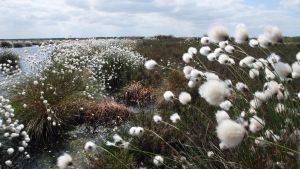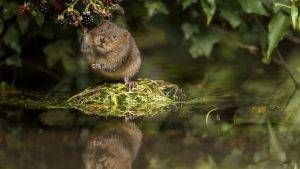The Peatland Code now has 100 projects registered under the UK Land Carbon registry.
The Peatland Code has seen recent rapid growth with a tripling in the number of projects registered in the last year and all registered projects are now predicted to deliver 3,194,681 tonnes of CO2e emissions reductions over their project lifetimes. These projects are securing 14,471ha of peatland restoration in Scotland, England and Wales. In 2022 alone, 36 projects have already been registered with many more under development.
The 100th project to be registered under the Code is Mar Estate (Cran Creagach) in Aberdeenshire, Scotland.
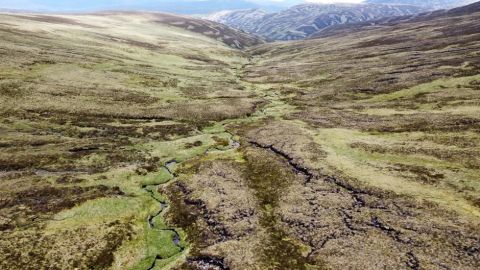
Image: Mar Estate © Mark Nicolson
The land is owned by Mark Nicolson and has a project area of 71.99 hectares. The site is classed as an actively eroding blanket bog and will be restored through reprofiling, bunding and revegetation.
Owner of the Mar estate, Mark Nicolson, says:
“The Mar Estate recognise restoring degraded peatland as a contribution towards tackling climate change”
“While this is our third restoration project, it is our first registered with the Peatland Code to realise the natural capital benefits associated with restoring Scotland's peatlands whereby ensuring additionality and support for long term commitment to maintain the improved habitat.
I hope to use the knowledge gained in this process to undertake further projects, and if the price of carbon offsets rises, to undertake much bigger schemes with fellow members of the East Cairngorms Moorland Partnership.
Throughout we have been supported by Peatland Action, the CNPA, and Caledonian Climate Partners, without whom these projects would not have happened.”
Launched in 2015 at the World Forum on Natural Capital the Peatland Code has undergone continual development to ensure alignment with the latest science and government policy on peatland restoration, greenhouse gas emissions and natural capital assessment. Recent updates in version 1.2 of the Code included new guidance to aid project development and changes to the project timeline with steps to include additional validation work ensuring the highest standard of projects from the outset.
The Peatland Code is one of only two standards in the UK that is government endorsed; the other being the Woodland Carbon Code and both sit together to form the UK Land Carbon registry. The UK Accreditation Service (UKAS) have recently confirmed that they are satisfied that the Peatland Code v1.2 meets the requirements for conformity assessment schemes required by ISO/IEC 14065 and EA-1/22. UKAS are now looking to accredit our validation/verification bodies against the Peatland Code and this phase is expected to complete in 2023.
Dr Renée Kerkvliet-Hermans, Peatland Code Coordinator at IUCN UK Peatland Programme says:
“This 100th project registered under the Peatland Code is a real milestone and the number of projects registered is currently growing exponentially which is fantastic. However, we have a massive task ahead of us to restore all our degraded peatlands urgently. Annually UK peatlands emit more carbon than our forests sequester. By restoring our peatlands we can tip them to storing carbon again instead of emitting carbon and deliver wider benefits for biodiversity, water and society.”
Future updates to the Peatland Code will include revised emissions factors, taking into account the latest scientific evidence, and are expected to include additional condition categories, including fens. The Peatland Code is also exploring how to quantify improvements in biodiversity and water which are delivered through peatland restoration projects. Paludiculture- essentially wetland agriculture- is planned for trial under the Peatland Code soon.
In addition to supporting peatland restoration in the UK, the Peatland Code is stimulating interest globally in private finance mechanisms for peatlands and The IUCN UK Peatland Programme is engaging with developing codes in Ireland and working together with Greifswald Mire Centre to develop Europe wide principles for country specific Peatland Codes in other European countries.
